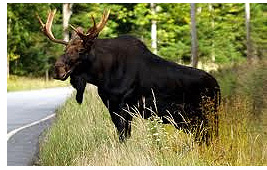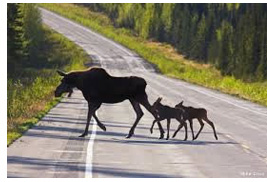
Project maps wildlife paths across U.S. 20 in Island Park
A four-year collaborative study in the Island Park area regarding wildlife-related hazards and improved safety on U.S. 20 and Idaho 87 has been completed. Finalization of the study was announced Feb. 4 by the Idaho Transportation Department (ITD), Idaho Department of Fish and Game (IDFG) and Wildlife Conservation Society (WCS).
The study focused primarily on moose and elk behavior and their movements across U.S. 20. ITD recorded 169 collisions with wildlife on the stretch of U.S. 20 between Ashton and Island Park from 2005 to 2009, resulting in moose, elk and deer fatalities, and millions of dollars in vehicle damage.
"Wildlife-vehicular collisions are a threat to both people and wildlife populations," said WCS Conservation Scientist Jon Beckmann, a principal investigator for the study. "Thankfully, through collaborations among partners like those involved here, and the emerging science of road ecology, we are mitigating that threat where possible."
As part of the study, scientists captured 37 adult female migratory elk and 42 adult female migratory and nonmigratory moose and fitted them with collars carrying global-positioning devices. The devices record animal locations via satellite, allowing researchers to track migration routes from their winter range in the St. Anthony Sand Dunes area and Sand Creek Wildlife Management Area to their summer feeding grounds in the Island Park Caldera of the Greater Yellowstone Ecosystem.
In addition to data on the number of crossings, scientists used novel modeling techniques to identify preferred crossing points, migration corridors and wildlife-movement patterns. Data indicated multiple specific locations along U.S. 20 and Idaho 87, where the highest probabilities of road crossings were similar between elk and moose.
Scientists recommended six of these areas for initial targeting of mitigation measures such as possible overpasses and underpasses, which allow wildlife to safely move over or under roads. In addition, associated fencing and warning systems to alert motorists of approaching wildlife could be considered.
"Animals migrating between Yellowstone National Park and the Sand Creek Desert of eastern Idaho must cross U.S. 20," said Shane Roberts, IDFG biologist. "To effectively manage these wildlife populations and to maintain migration paths between Yellowstone National Park and eastern Idaho, we must understand how animals successfully navigate highways and then work to maintain that capability."
WCS officials suggested to ITD officials that they consider addressing two additional locations of mitigation approaches for nonmigratory moose, as this group was responsible for the largest number of crossings of U.S. 20 and thus is more susceptible to collisions with drivers.
Vehicle-wildlife collisions are not the only threat to wildlife posed by highways. Roads can impede migrations, subdivide animal populations and habitats, and alter foraging and mating behavior.
Tim Cramer, ITD senior environmental planner and a principal investigator on the study, said, "This cooperative research will assist ITD in moving forward from research-based recommendations to management actions designed to help keep this area safe for the traveling public and for the important wildlife that we all treasure in the Island Park area."
 To augment telemetry data from radio collars, investigators used a low-tech approach to identify where noncollared animals cross the road. As part of the ongoing research, WCS and IDFG recruited the Idaho Master Naturalists, which is a group of citizen scientists trained to conduct surveys for animal tracks alongside U.S. 20 and to report wildlife observations.
To augment telemetry data from radio collars, investigators used a low-tech approach to identify where noncollared animals cross the road. As part of the ongoing research, WCS and IDFG recruited the Idaho Master Naturalists, which is a group of citizen scientists trained to conduct surveys for animal tracks alongside U.S. 20 and to report wildlife observations.
Next steps of the project include using the crossing-location data to determine how best to mitigate impacts of U.S. 20 on hooved migrations to protect wildlife and travelers.
Published 02-13-15